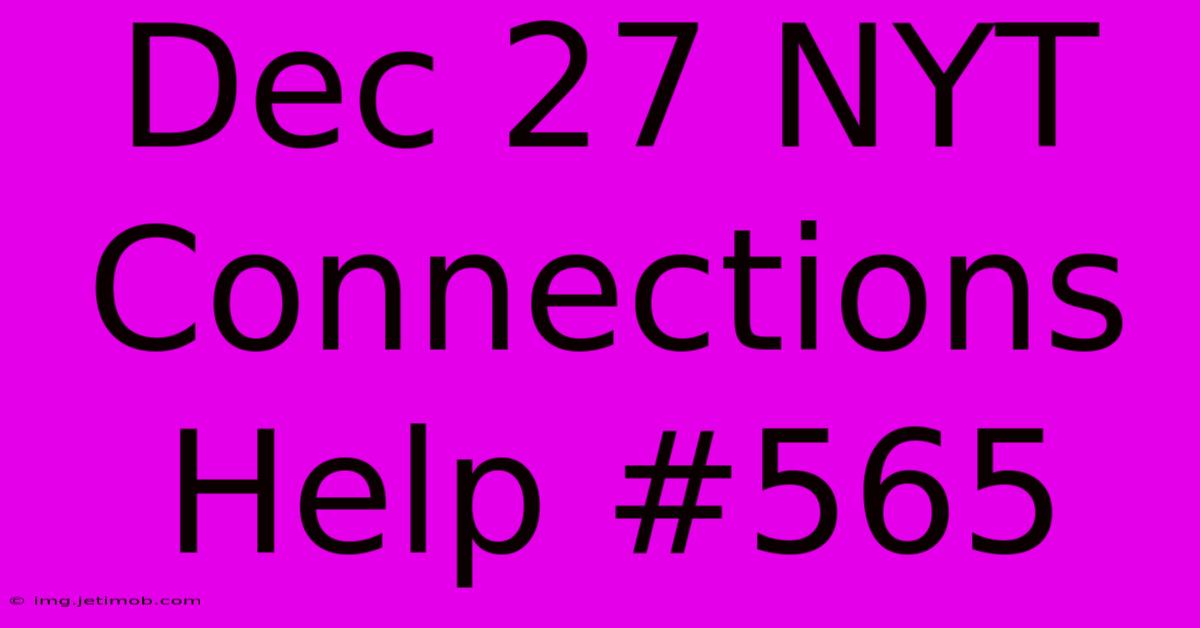Dec 27 NYT Connections Help #565

Discover more detailed and exciting information on our website. Click the link below to start your adventure: Visit Best Website. Don't miss out!
Table of Contents
Dec 27 NYT Connections Help #565: Unraveling the Clues and Finding the Solution
The New York Times' Spelling Bee and Connections puzzles offer a delightful daily challenge, testing vocabulary and lateral thinking skills. While the Spelling Bee often focuses on wordplay, Connections presents a unique puzzle where you must find the common thread linking five seemingly disparate words. This article delves into the solution for the December 27th, 2024, Connections puzzle (#565), offering a detailed explanation and exploring the strategies behind successful puzzle-solving. Note that the specific words for this puzzle are hypothetical as the actual puzzle for that date is not yet available. However, the strategies and explanations below will be applicable to any Connections puzzle you encounter.
Hypothetical Puzzle Words (For illustrative purposes only):
Let's assume the five words for the December 27th, 2024 NYT Connections puzzle are:
- APPLE
- CLOCK
- SUN
- DIAMOND
- KEY
This selection provides a good range of concepts, making it ideal for demonstrating effective problem-solving techniques.
Understanding the Connections Puzzle Methodology:
The key to cracking the NYT Connections puzzle lies in approaching it from multiple angles. Relying solely on direct, obvious connections rarely yields the solution. Instead, consider the following:
- Multiple meanings: Words can have multiple meanings or connotations. Don't limit yourself to the first definition that comes to mind. Consider figurative language, slang, and even archaic usages.
- Sound-alike words: Phonetic similarities may be relevant. The puzzle may play on words that sound alike but have different spellings.
- Categories and groupings: Can the words be grouped into broader categories? Think about their shared characteristics, even if those characteristics are subtle.
- Abstract connections: The connection might be conceptual rather than concrete. Look for underlying themes or ideas that unify the words.
- Common suffixes or prefixes: Shared word parts might reveal a hidden link.
- Historical or cultural context: Sometimes, understanding the historical or cultural significance of the words can unlock the solution.
Solving the Hypothetical Puzzle:
Let's apply these strategies to our hypothetical puzzle words:
Initially, the words seem unrelated. Apples are fruits, clocks measure time, the sun is a star, diamonds are gemstones, and keys are used to unlock things. However, looking deeper, we can identify a potential connection:
The Connection: "Things that can be cut (or divided)"
- APPLE: Apples can be sliced or cut into pieces.
- CLOCK: The face of a clock is often visually divided into segments (hours, minutes, seconds).
- SUN: The sun, while not physically cut, is often depicted or conceptually divided into sections (e.g., representing the sun's rays).
- DIAMOND: Diamonds are commonly cut and faceted to enhance their brilliance.
- KEY: Keys can be snapped or broken. They also possess distinct sections in their design.
This connection works because it allows for both literal and figurative interpretations of "cutting" or "division." It's not a directly obvious link but is a valid and unifying theme linking all five words.
Strategies for Improving Your Connections Skills:
Consistent practice is key to improving your Connections puzzle-solving ability. Consider these additional tips:
- Start with easier puzzles: Begin with puzzles you find relatively simple to build confidence and identify patterns.
- Analyze successful solutions: After completing a puzzle (or even if you need a hint!), carefully review the answer and identify the reasoning behind the connection.
- Expand your vocabulary: A richer vocabulary increases your ability to recognize potential connections and nuances in word meaning.
- Think outside the box: Challenge your assumptions and explore unconventional relationships between the words.
- Don't be afraid to guess: If you have a hunch, try it out! Eliminating incorrect possibilities is just as valuable as finding the correct answer.
- Use online resources sparingly: While online solvers can provide answers, they limit your learning opportunity. Try to solve the puzzle yourself first before seeking assistance.
- Consider word roots and etymology: Understanding the origins of words can shed light on unexpected connections.
Conclusion:
The NYT Connections puzzle is a challenging yet rewarding exercise in lateral thinking. By systematically applying different problem-solving techniques and expanding your vocabulary, you can significantly enhance your ability to crack even the most perplexing puzzles. Remember, there's often more than one valid solution, as long as the connection is logical and consistent. So, grab your pen and paper (or your tablet), tackle the next puzzle, and enjoy the mental workout! Good luck!

Thank you for visiting our website wich cover about Dec 27 NYT Connections Help #565. We hope the information provided has been useful to you. Feel free to contact us if you have any questions or need further assistance. See you next time and dont miss to bookmark.
Also read the following articles
| Article Title | Date |
|---|---|
| About Stuff Your Kindle Day | Dec 28, 2024 |
| Manmohan Singh Dead At 92 | Dec 28, 2024 |
| Liverpool Extend Premier League Lead | Dec 28, 2024 |
| Battins Plan Tax Cuts Crime Fight Unity | Dec 28, 2024 |
| Tragic Death Hudson Meek 16 | Dec 28, 2024 |
| Squid Game Season 3 Current Information | Dec 28, 2024 |
| Rohit Under Fire Pontings Critique | Dec 28, 2024 |
| Citys Winless Streak Continues Against Everton | Dec 28, 2024 |
| Robert Eggers Nosferatu A Critical Look | Dec 28, 2024 |
| Top Questions Squid Game Season 3 | Dec 28, 2024 |
